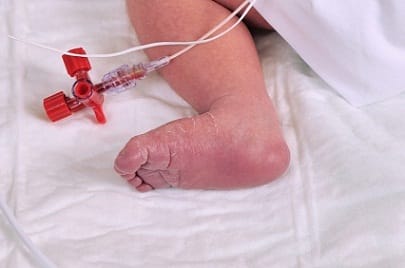For the last several years, headlines have told the story of the new drug scourge in the U.S. Prescription narcotic painkillers are being used and abused like never before. From young teens experimenting, to adults with legitimate prescriptions, to junkies needing a new, cheap high, the number of people falling victim to abuse continues to grow. The statistics point to the seriousness of the problem. From 2002 to 2010, the number of people abusing prescription painkillers rose 75 percent. Among teenagers, the increase was 25 percent. For some drugs, the numbers are even higher. The abuse of painkillers reaches across all demographics, including pregnant women. As a result of the rise in abuse, doctors and emergency rooms are witnessing a disturbing trend. They are seeing more and more infants born with an addiction to narcotics.
Neonatal Abstinence Syndrome What doctors are seeing in newborns is called neonatal abstinence syndrome, or NAS. This is a group of disorders that occur as a result of a baby having been exposed to addictive substances while in the womb. Any type of illegal or addictive substance can cause NAS, but doctors are seeing a rise in the incidence of cases caused by narcotic painkillers such as Vicodin, OxyContin, morphine and methadone. While a woman is pregnant, any substance she ingests goes through the placenta and to the developing fetus. The placenta connects the fetus and the mother so that the baby can get nutrients. When the mother uses a harmful substance, it also goes to her baby through the placenta. There is no filter to keep out drugs. If the mother gets hooked, so does her baby. These babies, through no fault of their own, are born with an addiction. As with any addiction, when they are born and no longer have access to the drug, they experience physical symptoms of withdrawal. This can include a wide variety of symptoms like diarrhea, excessive crying, irritability, sweating, vomiting, tremors, difficulty sleeping, seizures and fever. Because infants are smaller and more fragile than adults, they are at a greater risk of dying from withdrawal. Treatment is possible, but there can be serious, lasting damage. Silent Addiction on the Rise It only makes sense that as abuse of and addiction to narcotic painkillers increases across all demographics, that infants would be included. Across the country, medical professionals are seeing a rise in the incidence of NAS due to painkillers. In some locations, doctors are reporting increases of 10 times over a decade. Certain counties in Kentucky report a 330 percent increase in addicted infants being born, while in West Virginia, hospitals are reporting as many as one in 13 infants being born addicted. A study initiated in Tennessee reports that in 2009, more than 13,000 infants across the country were born with an addiction to prescription drugs. Many of the greatest increases in drug-addicted babies are being seen in the Appalachian regions of Kentucky, Tennessee and West Virginia. Abuse of narcotic painkillers is higher there than almost anywhere else in the country, and the babies are suffering for it. Treating and Preventing NAS Treating drug addiction in an infant involves giving the child small amounts of a narcotic drug to help relieve withdrawal symptoms and to wean the infant off of the substance. Morphine is often used for this purpose, but it must be done very carefully, as it can cause an infant to stop breathing. While doctors work to treat addicted babies, policymakers work to prevent the addiction epidemic. In Florida, for example, where 1,500 babies are born addicted to painkillers each year, a new public awareness campaign is being led by the state attorney general. With a website and billboards across the state, the campaign hopes to educate mothers about the dangers of using drugs while pregnant. Addiction in American adults is a serious problem, with narcotic painkillers representing the new drug of choice among many. The repercussions seen in infants are devastating, and should be enough to make everyone take the subject of addiction more seriously.
